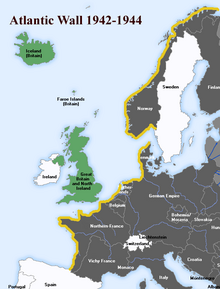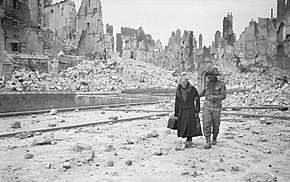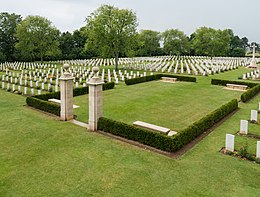Operation Overlord
To meet the conditions expected on the Normandy beachhead, special technology was developed, including two artificial ports called Mulberry harbours and an array of specialised tanks nicknamed Hobart's Funnies.The Allies failed to accomplish their objectives for the first day, but gained a tenuous foothold that they gradually expanded when they captured the port at Cherbourg on 26 June and the city of Caen on 21 July.[31] British planners reported to Prime Minister Winston Churchill on 4 October that even with the help of other Commonwealth countries and the United States, it would not be possible to regain a foothold in continental Europe in the near future.Churchill declined because he felt that even with American help the British did not have adequate forces to do it,[33] and he wished to avoid costly frontal assaults such as those that had occurred at the Somme and Passchendaele in World War I.[38] Churchill favoured making the main Allied thrust into Germany from the Mediterranean theatre, but the Americans, who were providing the bulk of the men and equipment, over-ruled him.[40] In part because of lessons learned in the Dieppe Raid of 19 August 1942, the Allies decided not to directly assault a heavily defended French seaport in their first landing.[42] The short operating range of British aircraft such as the Supermarine Spitfire and Hawker Typhoon greatly limited the number of potential landing-sites, as comprehensive air support depended upon having planes overhead for as long as possible.[e] The Germans regarded it as the most likely initial landing zone and accordingly made it the most heavily fortified region;[46] however, it offered the Allies few opportunities for expansion as the area is bounded by numerous rivers and canals.To gain the required air superiority needed to ensure a successful invasion, the Allies launched a strategic bombing campaign (codenamed Pointblank) to target German aircraft-production, fuel supplies, and airfields.To supplement the preliminary offshore bombardment and aerial assaults, some of the landing craft were equipped with artillery and anti-tank guns to provide close supporting fire.The double agent Juan Pujol García, a Spanish opponent of the Nazis known by the code name "Garbo", developed over the two years leading up to D-Day a fake network of informants that the Germans believed were collecting intelligence on their behalf.On the same night, a small group of Special Air Service (SAS) operators deployed dummy paratroopers over Le Havre and Isigny.[90] The following day, an additional estimated 749 American soldiers and sailors died when German torpedo-boats surprised members of Assault Force "U" conducting Exercise Tiger.Admiral Bertram Ramsay was prepared to commit his ships, while Air Chief Marshal Trafford Leigh-Mallory expressed concern that the conditions would be unfavourable for Allied aircraft.[86] As the Luftwaffe meteorological centre in Paris predicted two weeks of stormy weather, many Wehrmacht commanders left their posts to attend war games in Rennes, and men in many units were given leave.[115] Alarmed by the raids on St Nazaire and Dieppe in 1942, Hitler ordered the construction of fortifications all along the Atlantic coast, from Spain to Norway, to protect against an expected Allied invasion.[117] A report by Rundstedt to Hitler in October 1943 regarding the weak defences in France led to the appointment of Rommel to oversee the construction of further fortifications along the expected invasion-front, which stretched from the Netherlands to Cherbourg.In addition to concrete gun-emplacements at strategic points along the coast, he ordered wooden stakes, metal tripods, mines, and large anti-tank obstacles to be placed on the beach to delay the approach of landing craft and to impede the movement of tanks.Geyr argued for a conventional doctrine: keeping the Panzer formations concentrated in a central position around Paris and Rouen and deploying them only when the main Allied beachhead had been identified.In company with our brave Allies and brothers-in-arms on other Fronts, you will bring about the destruction of the German war machine, the elimination of Nazi tyranny over the oppressed peoples of Europe, and security for ourselves in a free world.By May 1944, 1.5 million American troops had arrived in the United Kingdom.[142] At Pointe du Hoc, the task for the two hundred men of the 2nd Ranger Battalion, commanded by Lieutenant Colonel James Rudder, was to scale the 30 metres (98 ft) cliffs with ropes and ladders to destroy the gun battery located there.[159] The repaired Arromanches harbour was able to receive around 6,000 tons of materiel daily and was in continuous use for the next ten months, but most shipments were brought in over the beaches until the port of Cherbourg was cleared of mines and obstructions on 16 July.[174] During Operation Perch, XXX Corps attempted to advance south towards Mont Pinçon but soon abandoned the direct approach in favour of a pincer attack to encircle Caen.[201] Eisenhower initially wanted to bypass the city to pursue other targets, but amid reports that the citizens were going hungry and Hitler's stated intention to destroy it, de Gaulle insisted that it should be taken immediately.The area was strongly held; the 4th and 6th Canadian brigades suffered many casualties over the course of three days as the Germans fought a delaying action in terrain well suited to defence.[207] On 17 September, Montgomery launched Operation Market Garden, an unsuccessful attempt by Anglo-American airborne troops to capture bridges in the Netherlands to allow ground forces to cross the Rhine into Germany.German preparations along the Atlantic Wall were only partially finished; shortly before D-Day Rommel reported that construction was only 18 per cent complete in some areas as resources were diverted elsewhere.[219] The Allied air forces, having flown 480,317 sorties in support of the invasion, lost 4,101 aircraft and 16,714 airmen (8,536 members of the USAAF, and 8,178 flying under the command of the RAF).[236] Prior to the invasion, SHAEF issued instructions (later the basis for the 1954 Hague Convention Protocol I) emphasising the need to limit the destruction to French heritage sites.[239] The Bayeux Tapestry and other important cultural treasures had been stored at the Château de Sourches near Le Mans from the start of the war, and survived intact.






Atlantic Wall










Battle of Long KhánhFrench invasion of Normandy (1202–1204)Western FrontWorld War IIbarrage balloonsOmaha BeachFranceAlliesUnited StatesUnited KingdomCanadaPolandAustraliaNew ZealandBelgiumCzechoslovakiaGreeceLuxembourgNetherlandsNorwaySouth AfricaSouthern RhodesiaGermanyItalian Social RepublicDwight D. EisenhowerSupreme Allied CommanderArthur TedderBernard MontgomeryTrafford Leigh-MalloryBertram RamsayAdolf HitlerFührerGerd von RundstedtOB WestErwin RommelArmy Group BAtlantic WallBodyguardFortitudeZeppelinTitanicTaxable, Glimmer & Big DrumCombined Bomber OffensivePointblankTransport PlanPostage AbleTarbrushFabiusCaen canal and Orne river bridgesMerville BatteryMallardAmerican SectorAlbanyBostonChicagoDetroitElmiraNormandy landingsPointe du HocGambitPort-en-BessinAmericanOperation ChastityBritishMulberryBrécourt ManorGraignesLa Haye-du-PuitsSaint-LôCarentanHill 30CherbourgBrévilleVillers-BocageLe Mesnil-PatryNormandy massacresArdenne AbbeyDouvresMartletWindsorCharnwoodJupiter2nd OdonAtlanticGoodwoodVerrières RidgeSpringBluecoatTotalizeHill 140LüttichTractableHill 262ChamboisFalaiseSaint-MaloMantes-GassicourtLa RochelleUshantLa CainePierres NoiresAudierne BayJedburghDingsonSamwestCooneyBulbasketHoundsworthLoytonKiplingDragoonWallace & HardyCemeteriesChastitySiegfried Line campaignChannel CoastDieppeLe HavreDunkirkBoulogneCalaisMarket GardenLorraineAachenHürtgen ForestScheldt
